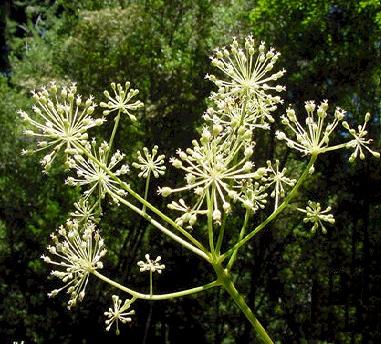|
|
|
Hansen's Northwest Native Plant Database |
|
|
|
Aralia californica
(California Spikenard, Elk Clover, Prairie Sagewort, California
Aralia)
|
 |
||||||||||||||||||||||||||||||
|
Plant Brief: Not really a clover, this large herbaceous perennial in the Araliaceae (Ginseng) family is the only member of that family native to the southwestern part of Oregon and to California's bay area. It is a striking shade plant reaching 3 to 9 feet at maturity. The large leaves (often more than 3 feet long) are sometimes described as "jurassic" because of their almost prehistoric appearance. |
|||||||||||||||||||||||||||||||
|
Elk Clover is an energetic plant creating drama in the garden with its bold form, huge leaves, attractive spikes of white flowers and its warm creamy yellow foliage and wine coloured streaked stems add unexpected punch to the fall garden. Description: Aralia californica's very large green leaves are compound with 3-5 leaflets between 6 - 12 inches long. Stalks of small white roundish clusters of star shaped flowers begin blooming in late spring to early summer, though more often from June to August or even October when grown in deeper shade. The flowers are sticky. The fruit of Elk Clover is round, dark purple to black and only about 1/4 inch in diameter. The buttery yellow autumn foliage is beautifully contrasted to the wine-coloured streaks which appear along the large stems. In true perennial fashion, this native dies to the ground each fall, only to return the next spring. Habitat and Geographic Range: Found in moist and shady spots, Aralia californica establishes naturally in many plant communities from southwest Oregon to western and central Californica, wherever it finds cooler, moister areas. Common neighborhoods are yellow pine forest, foothill woodland, chaparral, valley grassland, and wetland-riparian communities. It is especially prolific in the San Francisco Bay area of California. Spikenard tolerates sand, clay, serpentine and seasonal flooding. as long as there is regular water. Typically, Elk Clover selects moist shady areas, streamsides, or canyons at elevations below 6,500 feet. |
|
||||||||||||||||||||||||||||||
|
Its affinity for moist, shady habitats fits perfectly with its relative tenderness and great size. Look for it near streams or where water seeps into surrounding areas. Take these natural proclivities when selecting the planting site in your garden. I find it a very pleasing member of bog gardens. It is hardy in USDA zones 3-8. |
|||||||||||||||||||||||||||||||
|
Uses of Plant: Medicinally, this plant is used by First Nations: The root was used by Native Americans topically for skin ailments. This plant is sometimes substituted for other species of its genus which are used as herbal remedies. A preparation of the root has traditionally been used as an anti-inflammatory, douche, and cough suppressant. Decoction of roots used as a soak for arthritis, as a wash for open sores and itching. Decoction of dried roots taken for colds, fevers, stomach diseases, lung diseases, consumption. Holistic or herbal medicine practitioners suggest using this plant to treat tennis elbow, a musculoskeletal condition, reporting good success. The boiled and strained root is taken internally. This treatment is said to reduce the inflammatory condition within a week and complete relief has been achieved in a month. The Concow tribe call the plant mâl-ē-mē’ (Konkow language). |
|
||||||||||||||||||||||||||||||
|
|
|||||||||||||||||||||||||||||||
|
Native Plant Gardening/Wildlife Habitat: Butterflies flock to the flowers, and birds relish the fruits. Deer resistant. Propagation: New plants come easily from seeds collected in late summer between August 1st and September 30th. The Native Plant Network (www.nativeplantnetwork.org) reports:
|
|
||||||||||||||||||||||||||||||
|
Photos, above, credit: BotBln |
|||||||||||||||||||||||||||||||
|
Photo, left, credit: Udo Schmidt; Photo, right, credit: Udo Schmidt |
|||||||||||||||||||||||||||||||
|
Photo, center, credit: Udo Schmidt |
|||||||||||||||||||||||||||||||
|
Photo, left, credit: Alex Lomas; Photo, center, credit: BotBln; Photo, right, credit: BotBln |
Photos We Share!
|
||||||||||||||||||||||||||||||
|